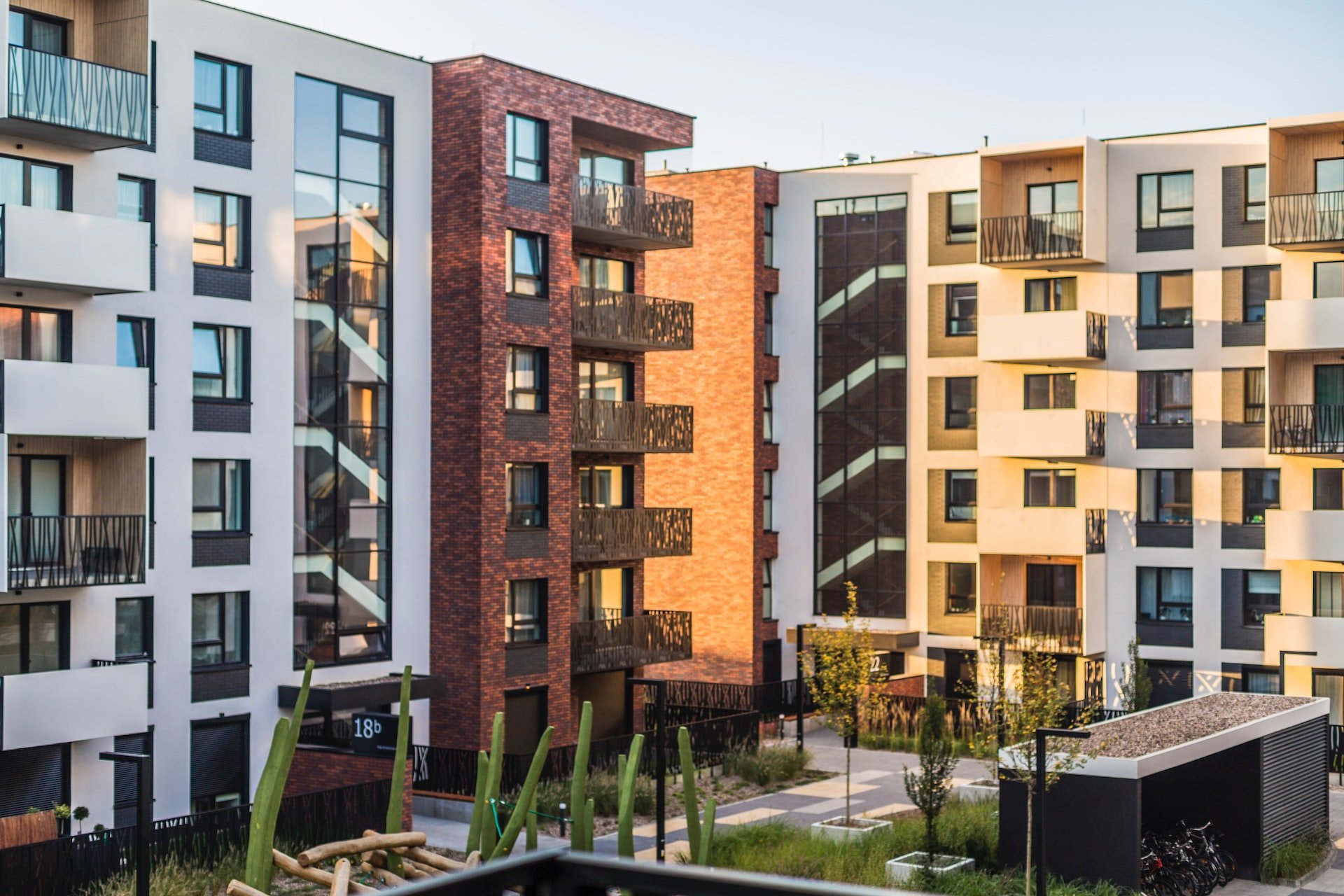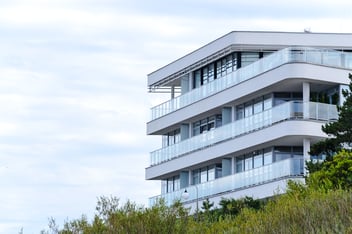-
Home
- Small Balance Commercial
- How to Buy an...
How to Buy an Apartment Complex as a First-Time Investor


With over 400,000 new apartments built in 2022 (a 50-year high), it’s no wonder more investors are looking to get a cut of the action. Not only do rental property owners earn 45% more than the median household, but owning apartments is also a tried-and-trusted way to build consistent passive income.
Typically, an apartment complex or building consists of four or more units. Because of this, they are often more expensive to purchase than single-family homes – but yield a higher return.
Knowing how to buy an apartment complex and finance the project is key to rounding out your investment portfolio and increasing rental income. Read through the steps below to better understand how to get started.
Table of Contents
- 1. Set Your Budget and ROI Goals
- 2. Identify Your Target Market
- 3. Get Pre-Approved
- 4. Look For the Right Types of Apartment Buildings
- 5. Find a Good Property Management Company
- 6. Finalize the Deal
- Pros to Investing in an Apartment Building
- Cons to Investing in an Apartment Building
- How to Build an Apartment Building
- FAQs
1. Set Your Budget and ROI Goals
Starting by outlining your return on investment (ROI) goals and total budget will help keep you profitable long-term. Consider how much money you have for a down payment and how much you’d be able to spend out-of-pocket per month (or per year).
If you’re new to investing in multifamily properties, you may be asking, “How much does an apartment complex cost?” While apartment complexes yield higher returns, they’re generally more expensive than single-family properties. Having at least $100,000 to use for a down payment is the first stepping stone to finding a suitable investment property. However, you may need more or less than this amount depending on what type of property you’re looking for, and in what areas.
Creating strategic partnerships with other residential and commercial real estate investors can also help you fill gaps in your budget. If you don’t have quite enough to invest in the type of property you’re looking at, or you want to gain experience from seasoned professionals, finding solid partnerships or real estate funds with multifamily properties can help.
2. Identify Your Target Market
Finding a strong market to invest in is key to developing a consistent stream of passive income. When analyzing market options, you first want to look at historical data – the National Association of Realtors is a good place to start. Once you’ve located a few general areas of interest, dive further into your analysis by reviewing the following in each area:
- Quality of life rankings
- Major employers
- Past and current employment and population growth
- Past and current market trends for rental properties
- Nearby amenities and tourist attractions
- Housing inventory
- Average home prices compared to average income
When running your analysis, look at all the above metrics together. A market with steady employment and population growth may be a solid option, but only if the average home price is less than two or three times the average income. For example, even though cities like San Diego and New York often experience positive employment and population growth, neither will be likely to produce much cash flow since the average home value is often ten or more times the average income.
3. Get Pre-Approved
Once you have an idea of how much you’re able to spend, if you’re financially able to invest in an apartment complex, and what areas you’re looking at, you should start the pre-approval process. Before reaching out to just any lender, be sure to do your research on the lender’s average interest rates and other benefits of working with them. Additionally, getting pre-approved through at least two or three different mortgage lenders can help you get the best interest rate and service possible.
At Revolution Realty Capital, we guarantee closing times of 10 days or less and the most competitive rates in the market. By partnering with us, you’ll benefit from over 40 years of experience in real estate lending, with a wide variety of loan options available.
Lorem ispum dolor sit umit

Lorem ipsum dolor sit amet, consectetur adipiscing elit. Proin interdum dolor a ullamcorper molestie. Vivamus in justo velit. Aliquam vehicula massa et venenatis placerat.
Subtitle in the post
Adipiscing elit. Proin interdum dolor a ullamcorper molestie. Vivamus in justo velit. Aliquam vehicula massa et venenatis placerat. In hac habitasse platea dictumst. Maecenas scelerisque ipsum et mauris aliquam, eget rhoncus enim facilisis. Praesent tincidunt vehicula ante, sed tempus libero vulputate at. Proin sed erat neque. Vivamus faucibus magna at facilisis suscipit.
- Taesent tincidunt vehicula ante, sed tempus libero vulputate.
- Lorem ipsum dolor sit amet, consectetur adipiscing elit.
- Taesent tincidunt vehicula ante, sed tempus libero vulputate.
- Lorem ipsum dolor sit amet, consectetur adipiscing elit.

Lorem ipsum dolor sit amet, consectetur adipiscing elit. Proin interdum dolor a ullamcorper molestie. Vivamus in justo velit. Aliquam vehicula massa et venenatis placerat.

Lorem ipsum dolor sit amet, consectetur adipiscing elit. Proin interdum dolor a ullamcorper molestie. Vivamus in justo velit. Aliquam vehicula massa et venenatis placerat.
4. Look For the Right Types of Apartment Buildings
Now that you have a budget planned out and a few different property financing options, it’s time to look more specifically at the types of buildings available to you and what purposes they serve.
Building Class |
Size & Purpose |
| Class A Building: Newer buildings (usually less than 10 years old) that include amenities such as pools, fitness centers, and office spaces. | Low-rise: Typically contains between four or seven stories, and sometimes less than four. |
| Class B Building: Buildings with fewer amenities but still less than 20 years old and in good condition. | Mid-rise: Usually contains between five and 10 stories. |
| Class C Building: Typically 20–30 years old with no amenities and could use some fixing up. | High rise: More often than not will have more than 10 stories and ample amenities. |
| Class D Building: Buildings in need of large-scale renovations, often in low-income areas. | Multi-purpose: Contains workspaces, living spaces, and/or entertainment spaces. |
Understanding the different building types can help you narrow your focus when looking at buildings for sale. For example, if you have a smaller budget, looking at Class A high rises likely won’t be worth your time unless you plan on partnering with other investors.
How To Find Apartment Complexes for Sale
The most obvious way to find apartments for sale is through online databases such as PropertyShark, LoopNet, and Crexi. When looking at online listings or talking with real estate agents for online listings, make sure you ask the following questions:
- Why is the property being sold?
- What are the main issues with the building?
- Are there any liens on the property?
- Who are the current tenants?
- How much is currently collected in rent per month?
- Are there detailed records of operating expenses?
- What exit strategies are available?
However, not all buildings for sale are listed online. Because of this, networking with real estate agents, other investors, and even real estate lawyers can lead to potential opportunities down the road. Attending real estate conferences and joining real estate investor groups are just two ways to network with these individuals.
5. Find Good Property Management Services
After you’ve found an appropriate building for your budget and ROI goals, you’ll want to consider how you’ll manage the everyday affairs of said building. While you may choose to manage it yourself, it may not be the best use of your time, particularly if you plan to invest in multiple buildings. This is where hiring a property management company comes in.
A good property management company or property manager collects the monthly rent, handles defaulting tenants, and keeps detailed records of the building – among other things. Hiring property management services can be expensive. However, if you don’t live near your real estate investment or don’t have the time necessary to take care of the more mundane tasks, it may be your best option.
Before hiring a property manager or property management company, look through online reviews to get a sense of what tenants think about them. You’ll also want to consider what services they offer and how their pricing compares with other companies in the area.
6. Finalize the Deal
Once you have your budget outlined, pre-approval from two or more lenders, a few specific buildings you may put offers on, and a plan for property management, you’re ready to finalize the deal and move forward. If one of your official offers is selected, you’ll then want to confirm a partnership with property management services as soon as possible or make a plan for how you will manage the property yourself.
Additionally, keep detailed records of different ROI metrics such as your capitalization rate and cash-on-cash returns. Owning an apartment complex can be a lot of work, so keeping detailed records can help you identify if your property is making you money. If your ROI isn’t as high as you’d like, you may want to start looking for different properties on the market.
Pros to Investing in an Apartment Building
Although owning an apartment complex can be more expensive than investing in single family homes, the benefits may actually outweigh the cons. However, seeing the benefits is often dependent on doing your due diligence first and making sure you’re putting your money in a reliable investment.
- Consistent cash flow: Renting units in an apartment building can provide reliable and consistent passive income.
- Reduced risk: Having multiple tenants throughout a building reduces risk of financial loss from vacancies.
- Economy of scale: Unlike owning four different single-family homes, an apartment building with four tenants is only subject to one set of property taxes and has only one roof, among other things. This increases your overall cash flow by decreasing your expenses.
- Tax benefits: In most instances, you can deduct operating expenses and maintenance costs associated with your property.
Investing in apartment buildings can help you build wealth quicker than investing in single family homes. However, as with any investment, there are also drawbacks.
Cons to Investing in an Apartment Building
The difference between a successful investor and an unsuccessful investor is how they handle difficulties that come along. Keep reading to learn about the cons to investing in an apartment building so you can be prepared for anything that comes your way.
- Lower liquidity: Apartment buildings often take longer to sell than other investments and the closing period can be time intensive.
- Potential vacancies: As with most types of real estate investments, you may experience vacant units, which can reduce your overall cash flow.
- Time-intensive: Finding and purchasing an apartment building can take months at a time, while managing it can be an even greater time investment.
- Up-front costs: Apartment buildings are significantly more expensive than single-family homes and other investment opportunities.
Despite these drawbacks, there are many things you can do to protect yourself and your money. Having a plan for how to find new tenants when others leave, balancing your portfolio with other investments, and hiring property management services are just a few things you can do to mitigate against some of the risks.
How to Build an Apartment Building
If you’d rather build an apartment building, you’ll have to go through a few more steps than if you are wanting to simply buy a property. The first steps are the same – determine your budget and ROI goals and locate your ideal market. Rather than getting pre-approved for a small balance commercial loan or something similar, you’ll want to get pre-approved for a ground-up construction loan.
Once you have your location picked out, you’ll need to find a construction crew or building company that fits your needs. After identifying a reliable construction partner, you can move forward with finalizing your financing and purchase of the land, and begin the construction process.
FAQ
Learning how to buy an apartment complex can be overwhelming at first. You’ve likely had more questions come up than we answered above, so look through the following frequently asked questions for additional insight.
What’s the difference between apartment complex vs apartment building?
Apartment complex and apartment building are often used interchangeably. Generally, however, apartment complexes contain more than one apartment building and typically include amenities such as swimming pools and fitness areas.
Is buying an apartment complex a good investment?
Yes, if you have available funds and are strategic about the property you purchase, buying an apartment complex can be a good investment. Although purchasing an apartment complex can be more expensive up front than buying a single-family home, it is often more beneficial in the long run.
For example, if you choose to live in the apartment complex, you could potentially have your own living expenses covered fully or partially through other tenants’ rent – leaving you with more money to invest elsewhere. Return on investment is also greater with multifamily properties because you have a greater number of tenants.
Now that you know how to buy an apartment complex, contact us today to start the process of building out your investment portfolio.
Taesent tincidunt
vehicula ante, sed tempus libero vulputate.
Taesent tincidunt
vehicula ante, sed tempus libero vulputate.
Taesent tincidunt
vehicula ante, sed tempus libero vulputate.
Taesent tincidunt
vehicula ante, sed tempus libero vulputate.

Key Takeaways
Adipiscing elit. Proin interdum dolor a ullamcorper molestie. Vivamus in justo velit. Aliquam vehicula massa et venenatis placerat. In hac habitasse platea dictumst. Maecenas scelerisque ipsum et mauris aliquam, eget rhoncus enim facilisis. Praesent tincidunt vehicula ante, sed tempus libero vulputate at. Proin sed erat neque. Vivamus faucibus magna at facilisis suscipit.
- Taesent tincidunt vehicula ante, sed tempus libero vulputate.
- Lorem ipsum dolor sit amet, consectetur adipiscing elit.
- Lorem ipsum dolor sit amet, consectetur adipiscing elit.
- Taesent tincidunt vehicula ante, sed tempus libero vulputate.

Proin interdum dolor a ullamcorper molestie. Vivamus in justo velit. Aliquam vehicula massa et venenatis placerat. In hac habitasse platea dictumst. Maecenas scelerisque ipsum et mauris aliquam, eget rhoncus enim facilisis. Praesent tincidunt vehicula ante, sed tempus libero vulputate at. Proin sed erat neque.”

Proin interdum dolor a ullamcorper molestie. Vivamus in justo velit. Aliquam vehicula massa et venenatis placerat. In hac habitasse platea dictumst. Maecenas scelerisque ipsum et mauris aliquam, eget rhoncus enim facilisis. Praesent tincidunt vehicula ante, sed tempus libero vulputate at. Proin sed erat neque.”

Lorem ipsum dolor sit amet, consectetur adipiscing elit. Proin interdum dolor a ullamcorper molestie. Vivamus in justo velit. Aliquam vehicula massa et venenatis placerat.



